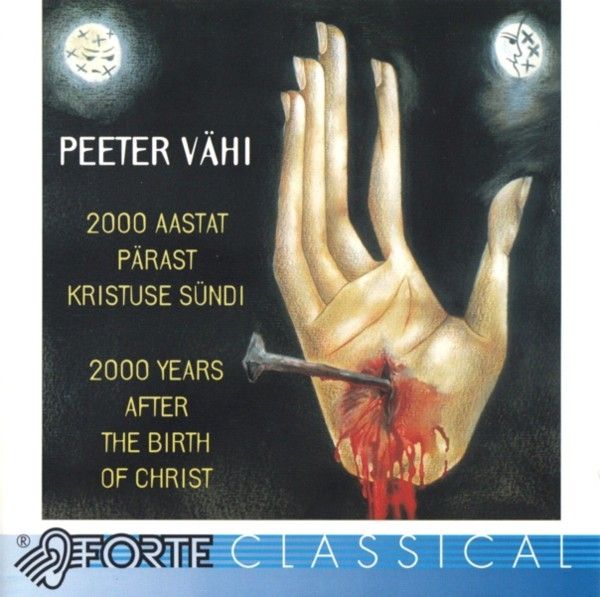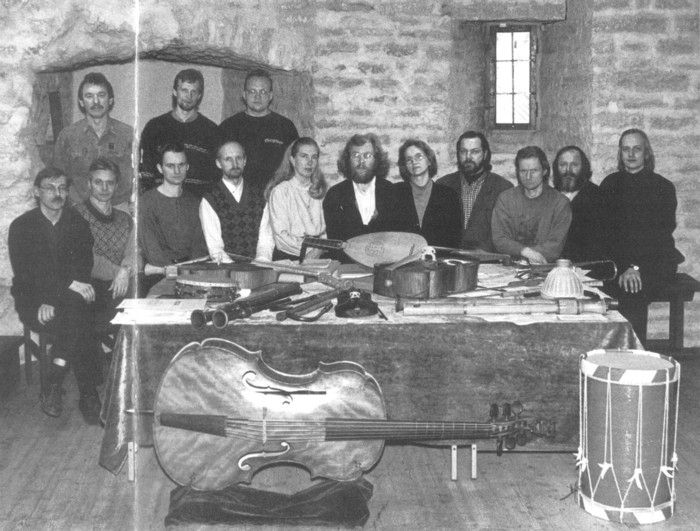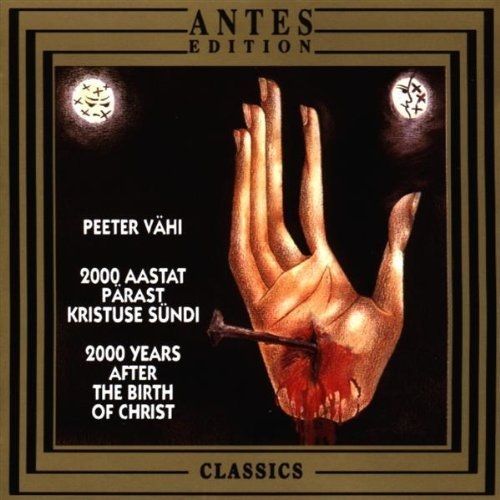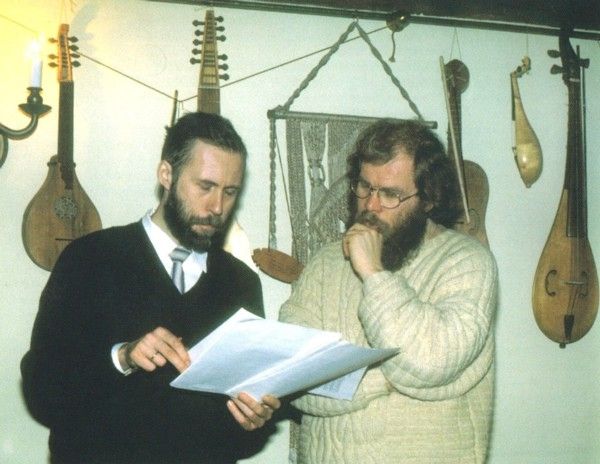
erpmusic.com
1995, Forte Records FD 0016/2
(1995, Antes Edition Classics BM-CD 31.9059)

erpmusic.com
1995, Forte Records FD 0016/2
(1995, Antes Edition Classics BM-CD 31.9059)
1. Maestoso. Con anima [6:19]
2. Eine feste Burg ist unser Gott [3:44]
by Martin Luther, †1546
3. Moderato [6:37]
4. Andantino [5:02]
5. Seele, sei zufrieden! [5:25]
by Benj. Schmolck, †1737
6. O du Liebe meiner Liebe [3:16]
by I. Scheffler, †1677
7. Maestoso. Allegro vivace [5:22]
8. A piacere. Andantino [4:37]
9. Sorge, Vater, sorge du [2:11]
by Ludämilia Elisabeth, Markgrafin von Schwarzburg-Rudolstadt,
†1672
10. Himmelan geht unsre Bahn [3:01]
by Benj. Schmolck, †1737, and Gerh. Tersteegen, †1769
11. Alla marcia. Pomposo [5:43]
Performed by:
HORTUS MUSICUS on authentic instruments (left channel)
Andres Mustonen — violin, bells, conductor
Mail Sildos — violin
Peeter Klaas — alto and tenor viola da gambas
Imre Eenma — violone
Neeme Punder — descant and sopranino recorders
Olev Ainomäe — descant bombardone
Valter Jürgenson — alto and tenor trombones
Tõnis Kuurme — bass dulcian
lvo Sillamaa — harpsichord
Helle Mustonen — soprano
Joosep Vahermägi — tenor
Jaan Arder — tenor
Riho Ridbeck — bass
THE “BAD” ORCHESTRA (right channel)
Kaia Urb — soprano
Peeter Vähi — keyboards, drum machine, voice
Composed, produced and mixed by Peeter Vähi
Engineered by lndrek Patte
Recorded at the Linnahall-Studio, Tallinn, in 1993

2000 AASTAT PARAST KRISTUSE SÜNDI
Et paremini mõista käesolevale heliplaadile salvestatud
muusikat, oleks kasulik teada ka selle eellugu. Viis aastat tagasi
leidis Tallinnas aset omamoodi tähelepanuväärne
kontsert, leidis aset Peeter Vähi teose "1990 aastat pärast
Kristuse sündi" esiettekanne. Selle ulatusliku teose aluseks pole
mitte niivõrd muusikalised ideed, vaid hoopis autori
maailmavaatest tulenevad kontseptsioonid. Kuigi Vähi
filosoofilised, esteetilised ja kultuuriajaloolised seisukohad tunduvad
olevat äärmiselt subjektiivsed, on nad siiski huvitavad ja
täiesti omal kohal loomingu lähtealusena.
Autor ise on kirjutanud kontserdi kavalehel: "Teoses "1990 aastat
pärast Kristuse sündi" ma olen püüdnud teineteisele
vastandada kahte täiesti erinevat poolust. Ühe moodustab
euroopa kultuuri kõrgperioodi muusika stilisatsioon,
mängituna ja laulduna vanamuusikaansambli poolt. Sellele vastandub
tüüpiline 20. sajandi muusika kaasaegse
sümfooniaorkestri esituses. Kuigi me elame veel 20. sajandis, ent
kõige äärmuslikuma modernismi-avangardismi ajastu on
jäänud juba selja taha, ning seetõttu on
võimalik ka sellele läheneda juba kui möödaniku
nähtusele retrospektiivselt. /.../ Veelgi suurenna sisulise
kontrasti ning samuti välise teatraalsuse saavutamiseks kavandasin
algselt teose nõnda, et kummalgi orkestril oleks oma dirigent,
see idee jääb paraku käesoleva ettekande puhul tehnilise
keerukuse tõttu teostamata. /.../ Teades, et euroopa kultuuri
kõrg- ja langusperioode täpselt määratleda
aastaarvudega või muusikastiilidega on peaaegu võimatu,
ei pretendeerigi ma oma hinnangutes vähimalgi määral
objektiivsusele. Muusika loomine on ülimalt isiklik, isegi
intiimne tegevus. Ja käesoleva teose loomise protsessis oligi
oluline vaid see, et mina mõtlen nii... Kõik muu
on tähtsusetu."
Teose esiettekanne tekitas Eesti muusikaringkondades küllaltki
suurt poleemikat, umbes nädala jooksul ilmusid arvustused paljudes
Eesti suuremates ajalehtedes. Toome siinkohal ära möned
väljavõtted:
"Vastuolulisus annab Vähi uuele teosele kriitilise läite, mis
teeb oopusest ühiskonnaelu sündmuse. Helilooja intuitsioon
osutub tema programmis väljendatud vaadetest tugeva maks. Stiililt
on teos harukordselt terviklik, mida kinnitavad paljud detailid. Sisu
kohta võiks öelda: protest võidutseva
keskpärasuse vastu. Ma ei tea, kas kõiki rahuldab selline
"valgus tunneli lõpus", mida kiirgab Vähi partituur, kuid
rohkemat pole praegusajal ilmselt võimalik loota."
("Õhtuleht", 15.09.90.)
"Peeter Vähi on ehe muusik. Tema uudisteosest jäi hea
mälestus, kuigi vastuoluline — tõsiduse ja narja,
puhta muusika ja teatraalsuse, usu ja uskmatuse piiril. Selle veidi
kummalise muusikaga sobis hästi kokku Andres Mustoneni
tavapärasele vastupidine dirigeerinnismaneer." ("Eesti Ekspress",
21.09.90.)
"On ilmne, et Vähi on oma suurteoses (kestusega üle tunni
aja!) taotlenud sügavaid kontraste. Sarnas muusika kulg ajas
jätab mulje kahest paralleelselt toimuvast protsessist, mis
küll aeg-ajalt teineteisele lähenevad, kuid ei ristu ometi.
See on umbes nii, et vaadates küll kahe silmaga, me näeme
siiski ühte puud. Täpselt samuti vaatab Vähi Euroopa
muusikale läbi kahe erineva prisma, kuid näeb ikkagi
ühte tervikut." ("Reede", 21.09.90.)
Nüüdseks on loodud teos, mille pealkiri erineb eelmisest vaid
aastaarvu poolest — "2000 aastat pärast Kristuse
sündi". Kas on tegemist päris uue teosega, uue versiooniga
või on koguni tegemist kahest teosest koosneva ulatusliku
tsükliga? Sellele küsimusele on üsnagi raske vastata.
Neis kahes teoses on palju ühist — sarnased printsiibid,
samad laulutekstid, sarnane muusika. Kuid on ka erinevusi:
sümfooniaorkestri osa on asendatud sopran-solisti, trummimasina
fling elektrooniliste klahvpillidega. Dirigent Andres Mustonen on
ümber orkestreerinud ka vanamuusikaansambli osa, kuna "Hortus
Musicuse" koosseisus on viie aasta jooksul toimunud küllaltki
suured muutused. Uus teos on ka mõnevõrra lühem,
seda nii ajaliselt kui ka osade arvult
Ma ühinen täielikult ühe kriitiku arvamusega, kes
ütles, et P. Vähi intuitsioon on tugevam programmis
formuleeritud printsiipidest. Teosel on veel mitmeid aspekte, millele
autor ise pole viidanud. Vähi muusikast peegeldub eestlaste
suhtumine luterlusse, Balti rahvaste suhtumine saksa kultuuri, samuti
üleolek hea ja halva kahesusest, üleolek dualistlikust
maailmavaatest... Partituuri igast leheküljest võime
välja lugeda, et helilooja seisab "õhtumaise kultuuriajaloo
lõpus". See kõlab ehk pisut pretensioonikalt, ent minu
silmis on "2000 aastat pärast Kristuse sündi" Euroopa ajaloo
omamoodi filosoofilis-muusikaline kokkuvõte.
K. DAMM

2000 YEARS AFTER THE BIRTH OF CHRIST
In order to get a better understanding of the music on the present
record, it could be useful to know its history. Five years ago, a
concert took place in Tallinn that was quite remarkable in its way
— it was the first performance of Peeter Vähi's "1990 Years
after the Birth of Christ". This extensive composition is based not so
much on musical ideas, but rather on conceptions derived from the
author's world view. Vähi's philosophical and aesthetic viewpoints
and ideas regarding music history seem to be highly subjective, and yet
they are interesting and fully relevant as a basis for his creation.
The author himself has written in the programme: "In my work '1990
Years after the Birth of Christ' I tried to contrast two absolutely
different sides. One of them is the stylized music of the European
Golden Age, as performed by the Early Music Consort. This is contrasted
with the music of Untergang des Abendlandes, performed by a modern
symphony orchestra. It is true that we still do live in the 20th
century, but the era of extreme avant-garde is over and so it is
possible to take a retrospective approach to it as a phenomen belonging
to the past /.../ In order to achieve a sharper contrast in essence and
also some outward theatricality, I originally planned a separate
conductor for each orchestra, but due to technical complexity the idea
will not be carried out in the present performance. /.../ Being aware
that it is hardly possible to date the ups and downs of European
culture or to define them in terms of styles of music, I do not try to
pretend to be objective in my estimations. The creation of music is a
very personal, one might even say, an intimate matter. And in the
process of creating the present work, the only thing that mattered was
that thought so... The rest is of no importance."
The first performance was a source of controversies in the musical
circles of Estonia. In about a week's time, critical rewiews were
published in almost all of the greatest newspapers of Estonia. I would
like to quote some passages:
"Contradictions render a spark of criticism to Vähi's new work,
which makes it quite an event in the social life. The composer's
intuition turns out to be deeper than his ideas formulated in the
programme. As for its style, the composition has an unusual quality of
completeness, which is confirmed by a number of details. As regards its
contents, one might say: protest against dominationg mediocrity. I
wonder whether everyone would be satisfied with this "light at the
other end of the tunnel" that radiates from Vähi's score, but
nowadays, evidently, it would be useless to expect more." ("Ohtuleht",
15.09.90.)
"Peeter Vähi is a genuine musician. His newest work made a good,
though controversial impression: on the borderline between seriousness
and a joke, pure music and thetricality, belief and disbelief. This
somewhat peculiar music harmonized perfectly with Andres Mustonen's
unconventional style of conducting." ("Eesti Ekspress", 21.09.90.)
"It is quite obvious that in his new major composition (lasting more
than an hour!) Vähi has tried to achieve deep essential contrasts.
The course of music trough time made an impression of two processes
going on parallelly, but never crossing. Just like looking with our two
eyes we can see a single tree, similarly, Vähi views European
music from two different aspects, but he still can see one complete
whole." ("Reede", 21.09.90.)
By now, another musical composition has been completed, whose title
differs from the previous one only in its date — "2000 Years
after the Birth of Christ". Is it a completely new work, a new version
of the old one, or is it an extensive cycle consisting of two
compositions? It is beyond my powers to give this question an
unambigous answer. These two have much in common — some
similarities in principles, the same texts, partically the same music.
However, there are also differences: in the new version, a soprano
soloist, electronic keyboards and a drum machine have been substituted
for the symphony orchestra. Andres Mustonen, the conductor, re-arranged
the part of the Early Music Consort, as considerable changes have taken
place in HORTUS MUSICUS within these five years. The new work is also
shorter, both as to its number of parts and its duration.
I fully agree with one of the critics who said that P. Vähi's
intuition turned out to be deeper than the verbal principles formulated
by him in the programme. The work has many more faces which the
composer would not or could not point out. The composition reflects, to
some extent, the attitude of Estonians towards Lutheran Christianity,
the attitude of the Baltic peoples towards the German culture. Also,
his music reveals the composer's power to transcend the duality of good
and bad, to transcend the dualist world view... Every page of the score
radiates with the author's conviction that he is standing at "the end
of the cultural history of the Occident". It may sound too pretentious,
but in my eyes "2000 Years after the Birth of Christ" is something like
a philosophical-musical summary of the history of Europe.
K. DAMM
